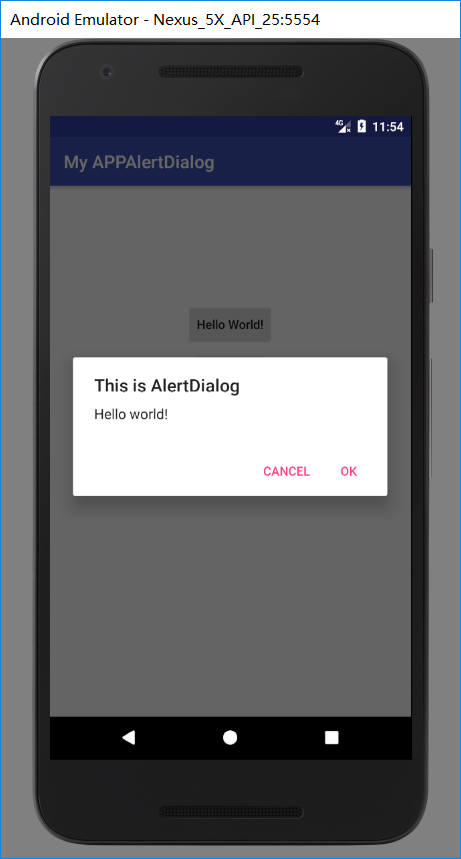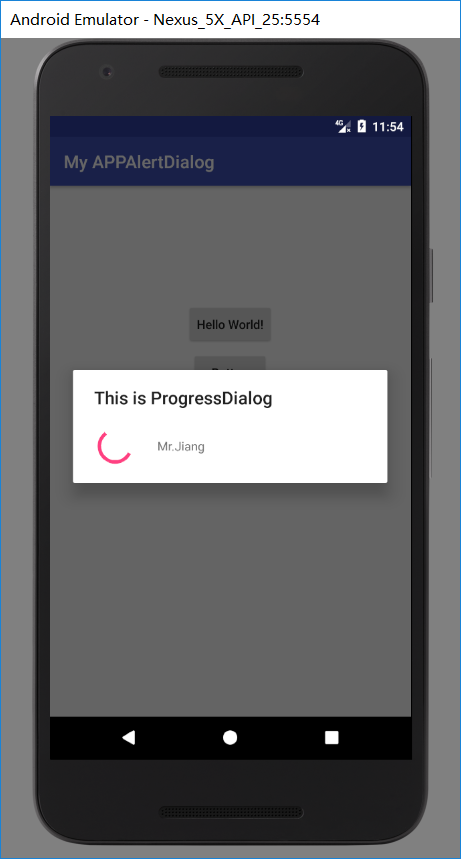Android中的AlertDialog和ProgressDialog用法
手机APP对话框是很多APP都有的下面来看下怎么实现的吧,
打开Android studio 然他自动创建好布局和类;
下面我们修改activity_main.xml中的代码
<?xml version="1.0" encoding="utf-8"?>
<LinearLayout
xmlns:android="http://schemas.android.com/apk/res/android"
xmlns:tools="http://schemas.android.com/tools"
xmlns:app="http://schemas.android.com/apk/res-auto"
android:layout_width="match_parent"
android:layout_height="match_parent"
android:orientation="vertical"> <Button
android:id="@+id/btn1"
android:layout_width="wrap_content"
android:layout_height="wrap_content"
android:text="Hello World!"
android:layout_gravity="center"
android:layout_marginTop="60pt"
android:textAllCaps="false"
/> <Button
android:id="@+id/btn2"
android:layout_width="wrap_content"
android:layout_height="wrap_content"
android:layout_gravity="center"
android:text="Button"
android:layout_marginTop="3pt"
android:textAllCaps="false"
/> </LinearLayout>
再activity_main.xml添加了两个按钮 分别是用于 AlertDialog 和 ProgressDialog的
下面我们再看ActivityMain中的代码
package com.example.administrator.myappalertdialog; import android.app.ProgressDialog;
import android.content.DialogInterface;
import android.preference.DialogPreference;
import android.support.v7.app.ActionBar;
import android.support.v7.app.AlertDialog;
import android.support.v7.app.AppCompatActivity;
import android.os.Bundle;
import android.view.View;
import android.widget.Button;
import android.widget.Toast; public class MainActivity extends AppCompatActivity implements View.OnClickListener {
private Button mBtn1;
private Button mBtn2; //声明控件
@Override
protected void onCreate(Bundle savedInstanceState) {
super.onCreate(savedInstanceState);
setContentView(R.layout.activity_main);
ActionBar actionbar = getSupportActionBar(); // 去除标题栏
if(actionbar!= null)
{
actionbar.hide();
}
mBtn1 = (Button) findViewById(R.id.btn1); //查找控件
mBtn1.setOnClickListener(this); //创建点击事件
mBtn2 = (Button) findViewById(R.id.btn2);
mBtn2.setOnClickListener(this);
} public void onClick(View view) //点击事件
{
switch(view.getId())
{
case R.id.btn1:AlertDialog.Builder dialog = new AlertDialog.Builder(MainActivity.this);
dialog.setTitle("This is AlertDialog"); //对话框标题
dialog.setMessage("Hello world!"); //内容
dialog.setCancelable(true); //可撤销性
dialog.setPositiveButton("OK", new DialogInterface.OnClickListener() {
@Override
public void onClick(DialogInterface dialog, int which) {
Toast.makeText(MainActivity.this,"OK",Toast.LENGTH_SHORT).show(); //提示内容
} //确定按钮的点击事件
});
dialog.setNegativeButton("Cancel", new DialogInterface.OnClickListener() {
@Override
public void onClick(DialogInterface dialog, int which) {
Toast.makeText(MainActivity.this,"Cancel",Toast.LENGTH_SHORT).show(); //提示内容
}//取消按钮的点击事件
});
dialog.show(); //全部显示出来
break;
//下面的原理一样。
case R.id.btn2:
ProgressDialog progressdialog = new ProgressDialog(MainActivity.this);
progressdialog.setTitle("This is ProgressDialog");
progressdialog .setMessage("Mr.Jiang");
progressdialog.setCancelable(false);
progressdialog.show();
break; default: Toast.makeText(MainActivity.this,"ERROR",Toast.LENGTH_SHORT).show();break;
}
}
}
上面ProgressDialog 没有确定和取消按钮,我们可以把progressdialog.setCancelable里面的值改成true,按下BACK键即可退出,还有可以用progressdialog.dismiss();来去取消关闭对话框;
下面附上第一个和第二个效果图.


Android中的AlertDialog和ProgressDialog用法的更多相关文章
- Android 中的AlertDialog使用自定义布局
Android使用指定的View开发弹窗功能 Android开发中进程会使用到我们的AlertDialog,但是比较可惜的是我们的Android原生的AlertDialog的效果又比较的简陋,这个时候 ...
- Android中的Handler的具体用法
Android UI操作并不是线程安全的并且这些操作必须在UI线程中执行.Android利用Handler来实现UI线程的更新的. Handler是Android中的消息发送器,其在哪个Activit ...
- Android中Parcelable与Serializable接口用法
转自: Android中Parcelable接口用法 1. Parcelable接口 Interface for classes whose instances can be written to a ...
- Android中Parcelable和Serializable接口用法
1. Parcelable接口 Interface for classes whose instances can be written to and restored from a Parcel. ...
- Android中Context的总结及其用法
在android中我们经常遇到这样的情况,在创建一个对象的时候往往需要传递一个this参数,比如:语句 MyView mView = new MyView(this),要求传递一个this参数,这个t ...
- Android中的AlertDialog使用示例五(自定义对话框)
在Android开发中,我们经常会需要在Android界面上弹出一些对话框,比如询问用户或者让用户选择.这些功能我们叫它Android Dialog对话框,AlertDialog实现方法为建造者模式. ...
- Android中的AlertDialog使用示例四(多项选择确定对话框)
在Android开发中,我们经常会需要在Android界面上弹出一些对话框,比如询问用户或者让用户选择.这些功能我们叫它Android Dialog对话框,AlertDialog实现方法为建造者模式. ...
- Android中的AlertDialog使用示例三(单向选择确定对话框)
在Android开发中,我们经常会需要在Android界面上弹出一些对话框,比如询问用户或者让用户选择.这些功能我们叫它Android Dialog对话框,AlertDialog实现方法为建造者模式. ...
- Android中的AlertDialog使用示例二(普通选项对话框)
在Android开发中,我们经常会需要在Android界面上弹出一些对话框,比如询问用户或者让用户选择.这些功能我们叫它Android Dialog对话框,AlertDialog实现方法为建造者模式. ...
随机推荐
- ZJNU 1528 - War--高级
类似于1213取水 可以把空投当作第0个城市 最后将0~n的所有城市跑最小生成树 /* Written By StelaYuri */ #include<iostream> #includ ...
- DataStructureAndAlgorithm--第 K 个最大值
设有一组 N 个数而要确定其中第 K 个最大者,我们称之为选择问题(selection problem). 该问题的一种解法就是将这 N 个数读进一个数组中,再通过某种简单的算法,比如冒泡排序法,以递 ...
- linux安装java步骤
本文转发自博客园-Q鱼丸粗面Q.博客园-郁冬的文章,内容略有改动 本文已收录至博客专栏linux安装各种软件及配置环境教程中 方式一:yum方式下载安装 1.查找java相关的列表 yum -y li ...
- Flask pythn Web 框架总结
Flask pythn Web 框架总结 一, Flask 介绍 Flask 是一个基于Python 实现的web 开发的'小型轻框架' 1. flask介绍 Flask是一个基于Python实现的w ...
- 达梦、oracel、mysql数据库兼容
联合表更新sql语句: 只支持mysql.oracle,不支持达梦 update to_pub_report a, to_pub_rec_process b set a.Satisfy_ID , a. ...
- ubuntu14 中文显示问号
1 终端执行 sudo locale-gen zh_CN.UTF-8 2 终端执行 export LC_ALL=zh_CN.UTF-8
- Office 365 邮件流
进入Exchange管理中心->点击左侧的“邮件流”->进入邮件流配置页面. 一.规则 规则也称传输规则,对通过组织传递的邮件,根据设定条件进行匹配,并对其进行操作.传输规则与众多电子邮件 ...
- shell_xtrabackup_backup_mysql
#!/bin/bash# Name: xtra_back_mysql.sh# Desc:该脚本使用xtrabackup工具对mysql数据库进行增量备份,根据自己需求可以自行修改# Usage:./x ...
- 吴裕雄--天生自然 JAVA开发学习:Applet 基础
import java.applet.*; import java.awt.*; public class HelloWorldApplet extends Applet { public void ...
- 文本输入框input将输入转换为统一大小写
转载地址:http://blog.csdn.net/yieryi_/article/details/52078596 文本输入框input将输入转换为统一大小写,通常有两种方法:JS和CSS方法. 1 ...
